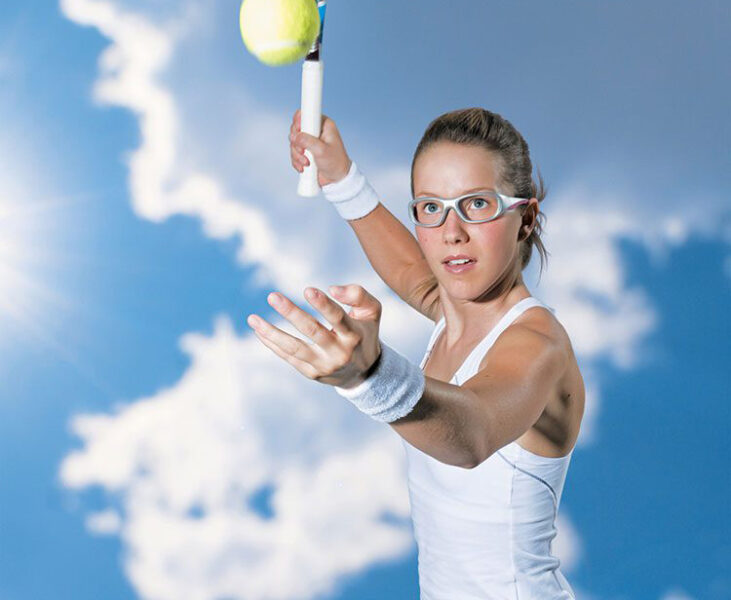In 2018, more than 28,000 people are treated for eye injuries related to sports activities. Using the right kind of eye protection while playing sports can help prevent serious eye injuries and even blindness.
Eye injuries prevented:
- Corneal abrasion – scratches on the cornea, the clear front part of the eye
- Inflamed iris – inflammation of the iris, the colored part of the eye
- Hyphema – blood in the clear part of the eye, between the cornea and iris
- Traumatic cataract – clouding of the lens of the eye
- Detached retina – when the retina, the layer of the eye that acts like the film in the camera of the eye to help you see, becomes detached from the back of the eye
- Fracture of the eye socket – broken bone that surrounds the eye
Prevent Blindness recommends that athletes wear activity-specific eye guards when participating in sports. Prescription glasses, sunglasses and even occupational safety glasses do not provide adequate protection. Prescription glasses should NEVER be worn as protective eyewear or underneath goggle type protective eyewear.
Sports-related eye injuries are common, so it’s important to know what kind of protective eyewear is appropriate for each activity.
For sports use, polycarbonate lenses must be used with protectors that meet or exceed the requirements of the current sport-specific ASTM (American Society for Testing and Materials) International, a global standards development organization. Polycarbonate lenses are the most impact resistant, thinner and lighter than plastic, shatterproof, and provide UV protection. Most sports have a specific ASTM standard which are directed to the specific risks likely to be encountered in that sport. Look for the appropriate ASTM standard on the product and/or its packaging before making a purchase. Consult your eye doctor or the ASTM website (https://www.astm.org/) to find the most current and appropriate ASTM standard for the sport you are playing.
Baseball/Softball
Type of eye protection:
- Faceguard/Visor (attached to helmet): Helmet mounted faceguards/visors are the most protective. Clear faceguards/visors made of polycarbonate material. Polycarbonate is impact resistant, thinner and lighter than plastic, shatterproof, and provides UV protection. Helmet mounted faceguards/visors should be National Operating Committee on Standards for Athletic Equipment (NOCSAE) approved. https://nocsae.org/
- Sports eye guards (goggles or spectacles): These offer reduced protection from a helmet mounted faceguard or visor but are better than a naked eye exposed to a ball impact which can result in eye/vision loss. Sports eye guards should be approved to ASTM F803-19 or the most current sport specific ASTM standards.
Basketball
Type of eye protection:
- Sports eye guards (goggles or spectacles): Sports eye guards used for basketball should be approved to ASTM F803-19.
Soccer
Type of eye protection:
- Sports eye guards (goggles or spectacles): Sports eye guards used for soccer should be approved to ASTM F803-19.
Football
Type of eye protection:
- Polycarbonate visor shield attached to faceguard: These shields offer additional protection against objects having the potential to penetrate openings in the faceguard grid. They also provide the wearer UV protection.
Hockey
Type of eye protection:
- Wire or polycarbonate visor/shield (attached to helmet): A polycarbonate mask attached to a helmet provides the most protection without cage wires blocking the visual field (Note: goal tenders must wear full wire cage face protectors). All hockey eye and face protectors should bear The Hockey Equipment Certification Council (HECC) approval label. http://www.hecc.net/
Women’s Lacrosse
Type of eye protection:
- Sports eye guards (goggles): Sports eye guards used for women’s lacrosse should be approved to ASTM F3077-17 or the most current version of that standard. Beginning in 2020, women’s lacrosse eye protectors must bear the Safety Equipment Institute (SEI) Certification Mark. https://www.seinet.org/
Field Hockey
Type of eye protection:
- Sports eye guards (goggles): Sports eye guards used for field hockey should be approved to ASTM F2713-18 or the most current version of that standard.
Racket Sports
Type of eye protection:
- Sports eye guards (spectacles or goggles): Sports eye guards used for Racket Sports (e.g. Racquetball, Squash) should be approved to ASTM F3164-19 or the most current version of that standard.
